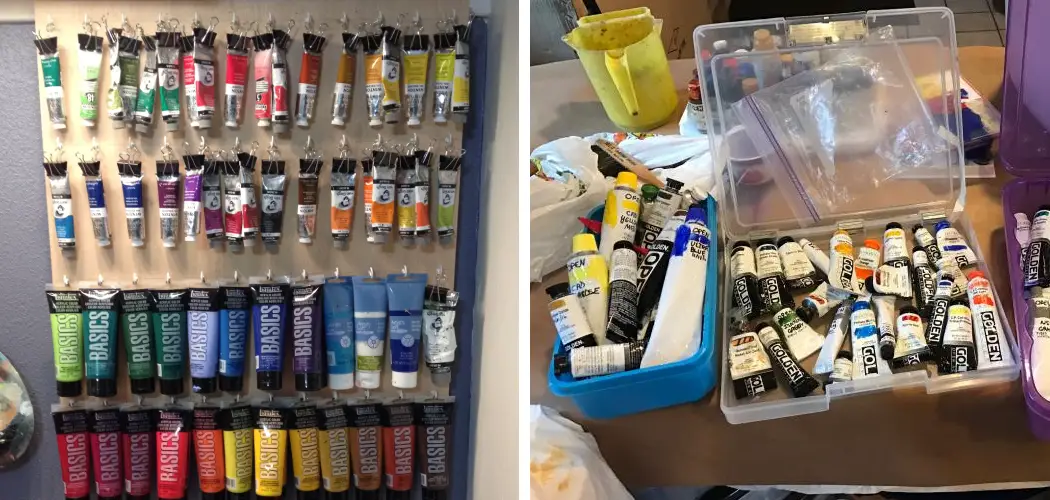Properly storing acrylic paint is essential for preserving its quality and ensuring it remains usable for years to come. Paint that is not stored correctly can become unusable due to exposure to air, light, or fluctuating temperatures. Furthermore, if you plan on using the same color multiple times, proper storage will ensure that it does not discolor or change consistency.
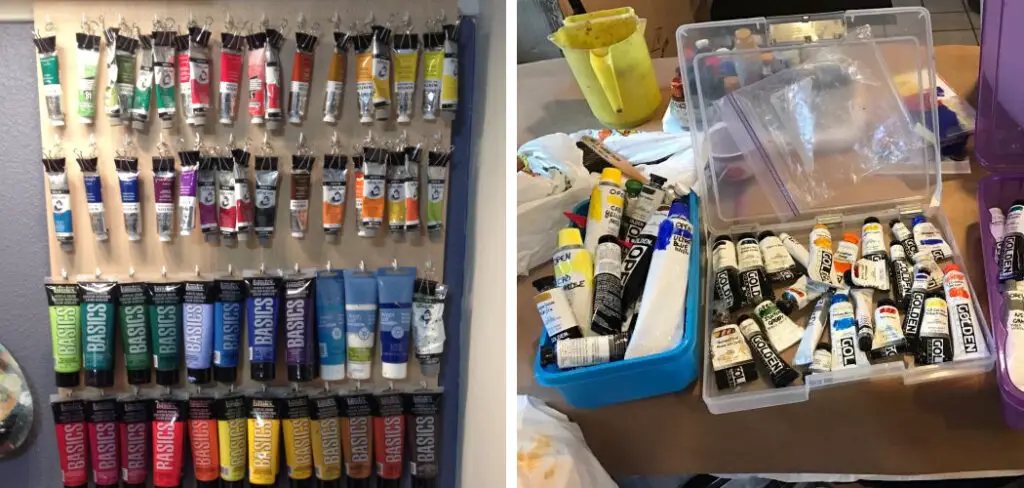
One of the advantages of storing acrylic paint is that it doesn’t dry out as quickly or easily as other types of paints, making it a great choice for artists who need to keep their artwork and supplies fresh. Acrylics also don’t require solvents or additives in order to maintain their texture, so they are much easier to store.
Acrylics can be stored in various containers, including airtight jars or plastic bags. This makes it easy to keep them organized and safe from dust and other environmental factors that could damage the paint. In this blog post, You will learn how to store acrylic paint in detail.
Step-by-step Instructions for How to Store Acrylic Paint
Step 1: Inspect the Paint
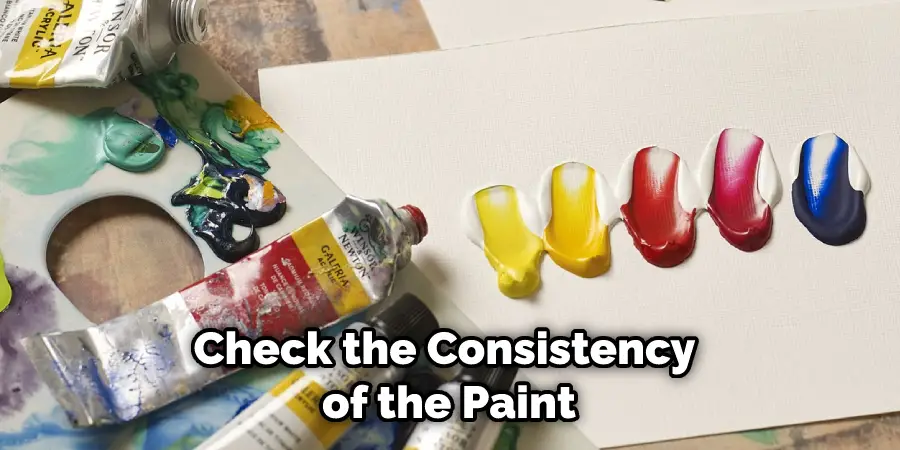
Before storing your acrylic paint, ensure it is free of mold or contaminants. Check the consistency of the paint; if it feels too thick, give it a light stirring before using.
Step 2: Choose an Appropriate Container
Acrylic paints should be stored in tightly sealed plastic containers such as jars or bottles. Glass and metal containers should be avoided, as the paint may react with the material and cause an unpleasant odor.
Acrylic paints should be stored in a cool, dry place away from direct sunlight. The paint should not be exposed to extreme heat or cold, as this can cause it to become too thick or too thin.
Step 3: Avoid Freezing Temperatures
Acrylic paints should never be frozen, as this can cause the pigments to separate from the paint’s binder and render it unusable. If you need to store your paint for a long time, keep it in a cool place between 40 and 50 degrees Fahrenheit.
Step 4: Store Paints Separately
When storing multiple colors of acrylic paint, it is important to keep them separated in order to avoid color contamination. Use separate containers or dividers within a container for each color of paint you are storing. Make sure the lid of your paint container is tightened securely. This will help to keep the paint fresh and prevent it from drying out or becoming contaminated by dust and dirt particles.
Step 5: Label Containers
Be sure to label each container with its contents. This will help you easily identify which colors are stored in each container, so you can quickly access them when needed. To help keep your paint fresh and free of moisture, add a desiccant packet with each container you store. Desiccants are small packets filled with a material that absorbs moisture from the air, which can help extend the life of your acrylic paints.

Step 6: Store in the Correct Position
Acrylic paints should be stored vertically, with the lids pointing downwards. This will help to ensure that any pigments that have settled at the bottom of the container do not contaminate other colors in order to keep your paint fresh and in good condition, store it away from any direct sources of heat or sunlight. Paints that become too hot can thicken and separate, rendering them unusable.
Following these steps will help you properly store your acrylic paints and keep them in optimal condition for years. With the right storage techniques, you can easily maintain an extensive collection of acrylic paints and ensure their longevity.
Safety Tips for How to Store Acrylic Paint
- Store acrylic paints in a cool, dry place to prevent them from drying out or getting too hot.
- Store acrylic paints away from direct sunlight, which can cause the colors to fade over time.
- Ensure your storage containers are airtight so that any leaks or spills can be contained and cleaned up easily.
- Label all containers with the name of the paint and color, as well as the date it was purchased or opened.
- Keep acrylic paints away from heat sources such as radiators, stoves, and fireplaces, which can cause them to become too hot and lose their vibrancy.
- Do not store acrylic paints in the refrigerator or freezer, as this can cause them to become too cold and crack when used.
- Give each paint a good shake before use, as this will help ensure it has the correct consistency for painting.
- Store paints in an upright position to prevent them from spilling or running out of their containers.
By following these safety tips, you can be sure that your acrylic paint will remain in good condition for as long as possible. It’s important to take the time to properly store your paint to make sure that it stays vibrant and usable for its entire lifespan.
How Should You Store Acrylic Paint So That It Won’t Dry Out or Become Unusable?
When it comes to storing acrylic paint, the key is to keep it in an airtight container. This will help prevent moisture and oxygen from entering the container and spoiling the paint. It’s also important to store your acrylic paints away from light sources such as sunlight or fluorescent lights, as these can cause colors to fade or shift over time.
The best way to store acrylic paints is by using airtight plastic containers. These containers come in various sizes and shapes, so you should be able to find one that fits your needs. To ensure the paint does not dry out in the container, use a lid or sealant to keep air from getting inside. Also, avoid having any metal parts in contact with the paint, as this could cause discoloration or rusting.
How Do You Protect Your Acrylic Paint From Damage Due to Extreme Temperatures?
When it comes to storing acrylic paint, the temperature is a major factor. Extreme temperatures can cause the paint to degrade and become unusable. To protect your acrylic paints from damage due to extreme temperatures, you should follow a few simple steps. First, always store your acrylic paints in a cool, dry place without direct sunlight.
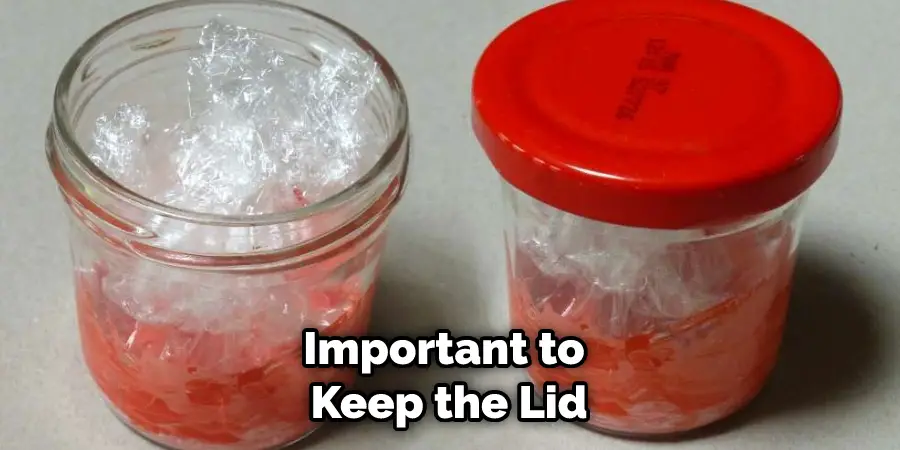
If possible, store them in a temperature-controlled space, such as an air-conditioned room or basement. It’s also important to keep the lid of your acrylic paint containers closed when not in use and make sure they are tightly sealed.
Second, if you are going to be traveling with your acrylic paints, consider investing in an art supply case with temperature control. This will help keep the paint from getting too hot or cold, which can cause it to degrade. Finally, consider investing in a larger airtight container for storing your acrylic paints.
This can help reduce exposure to extreme temperatures and protect your paint from becoming damaged over time. By following these simple steps, you can ensure that your acrylic paints remain in excellent condition and ready to use for years to come.
How Often Should You Replace the Lids on Your Acrylic Paint Containers to Ensure a Tight Seal?
To ensure a tight seal when storing your acrylic paint, it is important to regularly check and replace the lids on any containers you’re using. How often this should be done depends largely on the conditions of storage – if stored in an area that experiences high temperatures and humidity or frequent changes in temperature, then it is suggested to check and replace the lids more often.
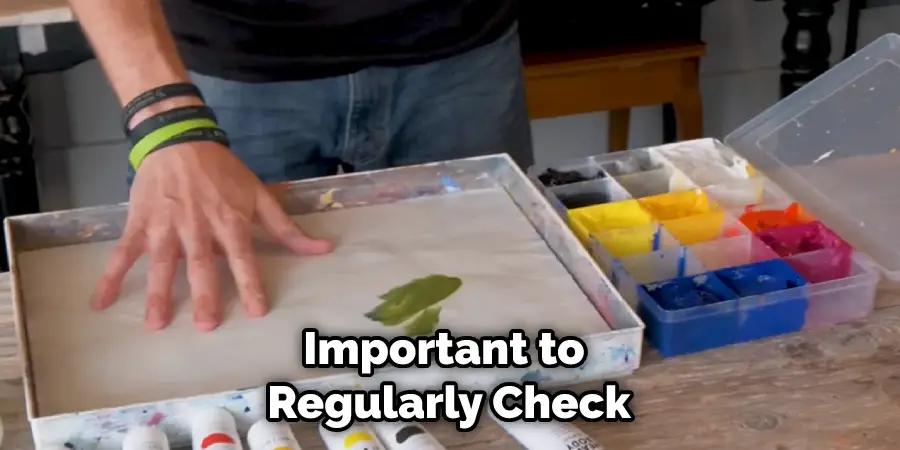
It is also important to ensure the lid fits tightly and securely onto the container – if it does not fit properly, you should replace it with one that does.
When replacing a lid, take extra care to ensure there are no gaps or openings in which air can get in and cause your paint to dry out. If air is able to enter the container, it can cause the paint to thicken and create a seal that prevents air from getting out. This would cause your paint to dry out faster than normal, resulting in poor performance when using it.
By taking the time to regularly check and replace the lids on your acrylic paint containers, you can ensure that your paint remains in excellent condition for as long as possible.
How Should You Store Acrylic Paints for Safety Reasons?
It is important to store acrylic paint correctly so that it is easy to use and remains safe to handle. When not used, paints should be kept in a cool and dry place, preferably away from direct sunlight or heat sources. It’s also a good idea to keep paints in an airtight container to avoid any contamination. It is best to store paints in original containers with tightly secured lids. If necessary, you can also store paint in resealable plastic bags.

To ensure that the paint does not dry out, it is important to ensure the lids are kept closed and airtight at all times. Additionally, it’s a good idea to label each paint container so that it is easy to identify when you are ready to use them. If you plan on storing acrylic paints for an extended period of time, consider using a dryer sheet or silica gel packets to help keep the paint from drying out. This will also help prevent any possible contamination in the future.
How Do You Clean Up Dried or Spilled Acrylic Paint From Surfaces, Clothing, and Other Materials?
It can be difficult to clean up if you have spilled acrylic paint on a surface or fabric. To avoid damaging the surface or material permanently, start by using a spoon or other tool to scrape away as much of the paint as possible. Next, use mild soap and water to carefully scrub the area until all traces of paint are removed.
If you need to, use a soft brush or rag to help loosen the paint, and then rinse with warm water. Use mineral spirits or turpentine with a rag or sponge to clean away any residue for oil-based paints. Be sure to keep the area wet while scrubbing and rinse thoroughly after cleaning.
If the paint has dried and hardened, you may need to use a solvent such as rubbing alcohol or acetone. Apply the solvent and let it sit on the surface for 1-2 minutes before scrubbing with a brush. Finish by rinsing with warm water or wiping clean with a damp cloth.

Start by scraping away any loose paint with a dull knife or spoon for clothing or fabrics. Next, soak the item in warm water with mild laundry detergent for about 30 minutes before scrubbing. If needed, you can use a soft brush to help loosen any remaining paint and then rinse with warm water.
Conclusion
One of the main disadvantages of acrylic storage paint is that it can dry out very quickly. Acrylic paints are water-based, so they require a tightly sealed environment in order to preserve their freshness.
The paint can become thick and difficult to work with if stored in an open environment (such as on a shelf or table). Furthermore, acrylic paints can become brittle and crack if exposed to too much light for prolonged periods. To prevent this from happening, it is important to store the paint in a cool, dark place away from direct sunlight.
In conclusion, storing acrylic paint correctly can help maintain its quality and ensure that it will last for a long time. It is important to keep the lids of your containers tightly sealed, store them at room temperature in a dry area away from direct sunlight, and discard any outdated or contaminated paints. I hope this article has been beneficial in learning how to store acrylic paint. Make Sure the precautionary measures are followed chronologically.
About
Angela is the chief editor of Indoorense. She began her career as an interior designer before applying her strategic and creative passion to lifestyle and home.
She has close to 15 years of experience in creative writing and online content strategy for housekeeping and cleaning,home decorations as well as other efforts.
She loves her job and has the privilege of working with an extraordinary team. She lives with her husband, two sons, and daughter in Petersburg. When she’s not busy working she spent time with her family.

